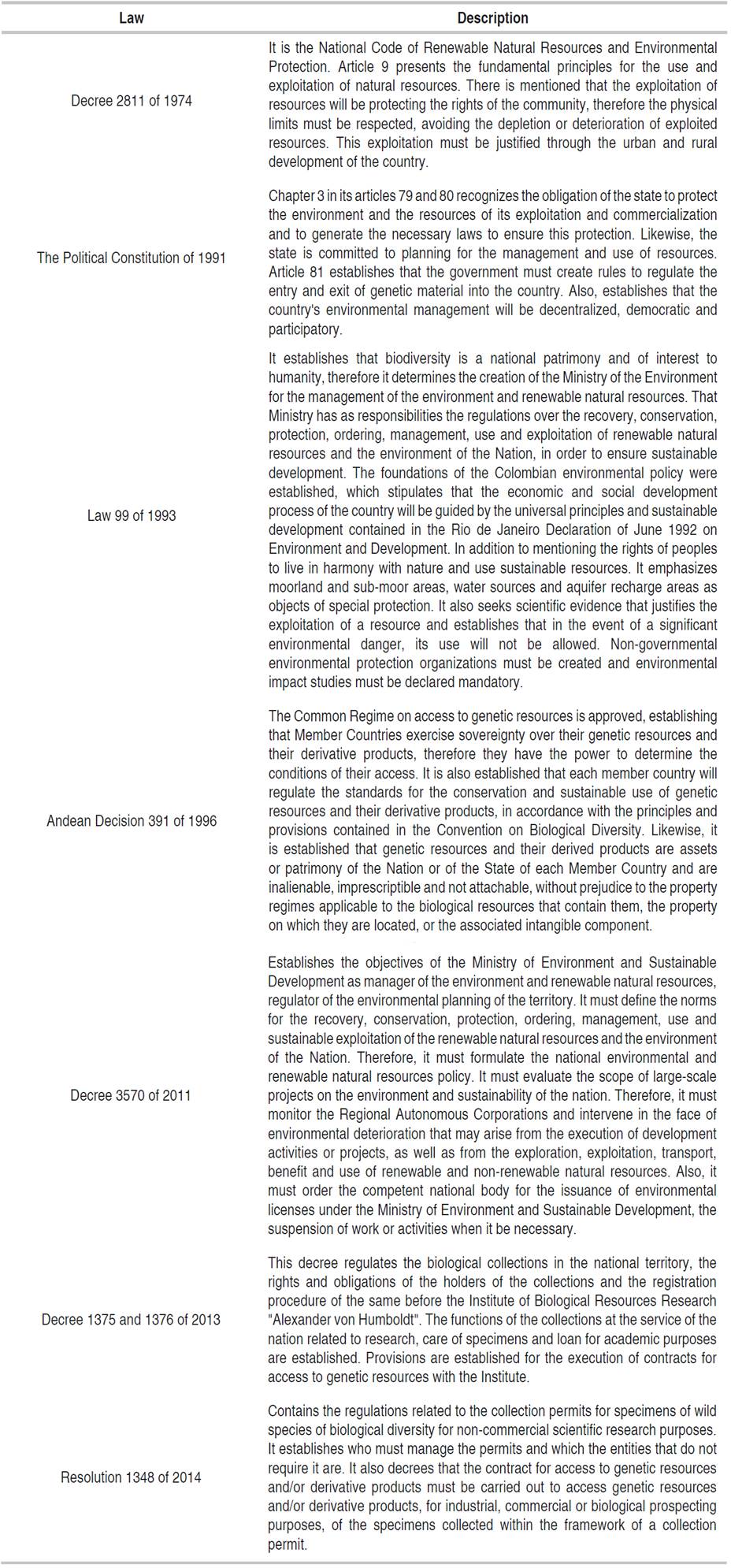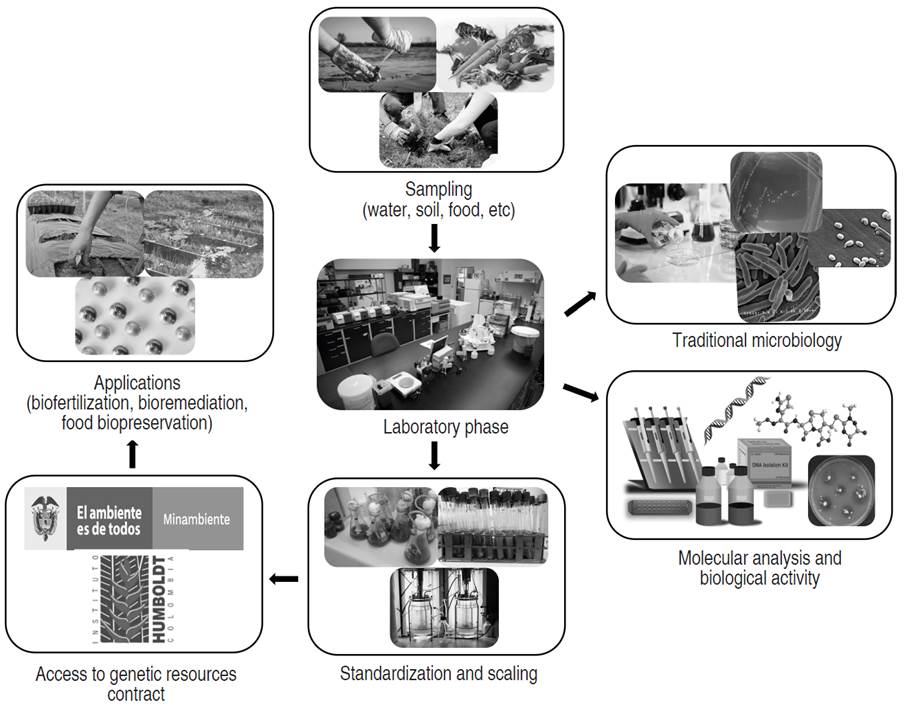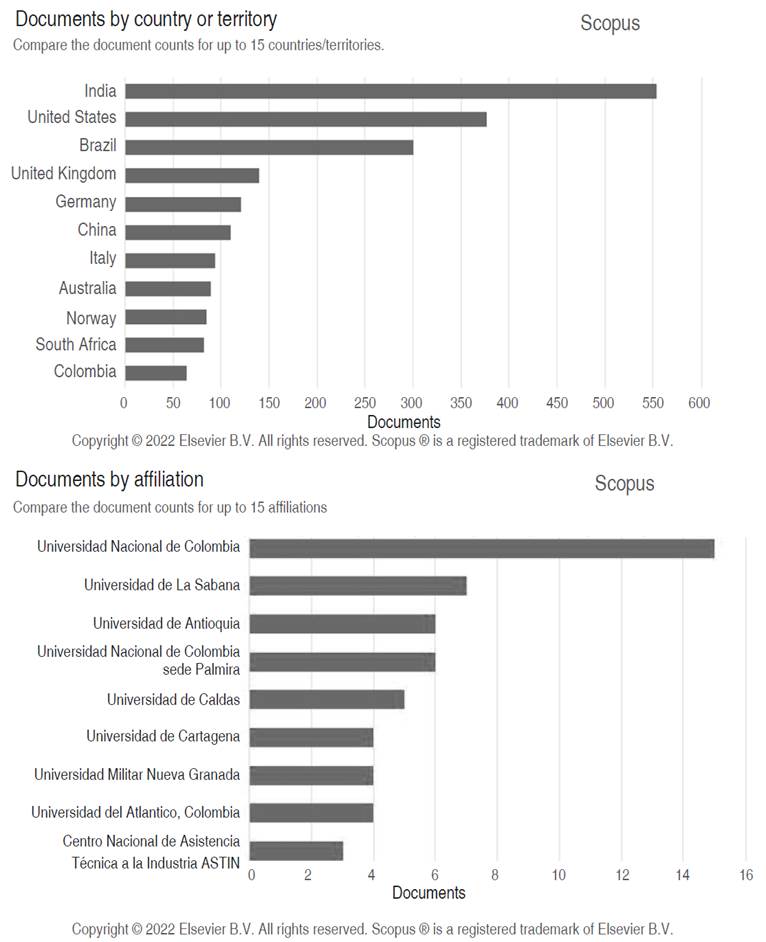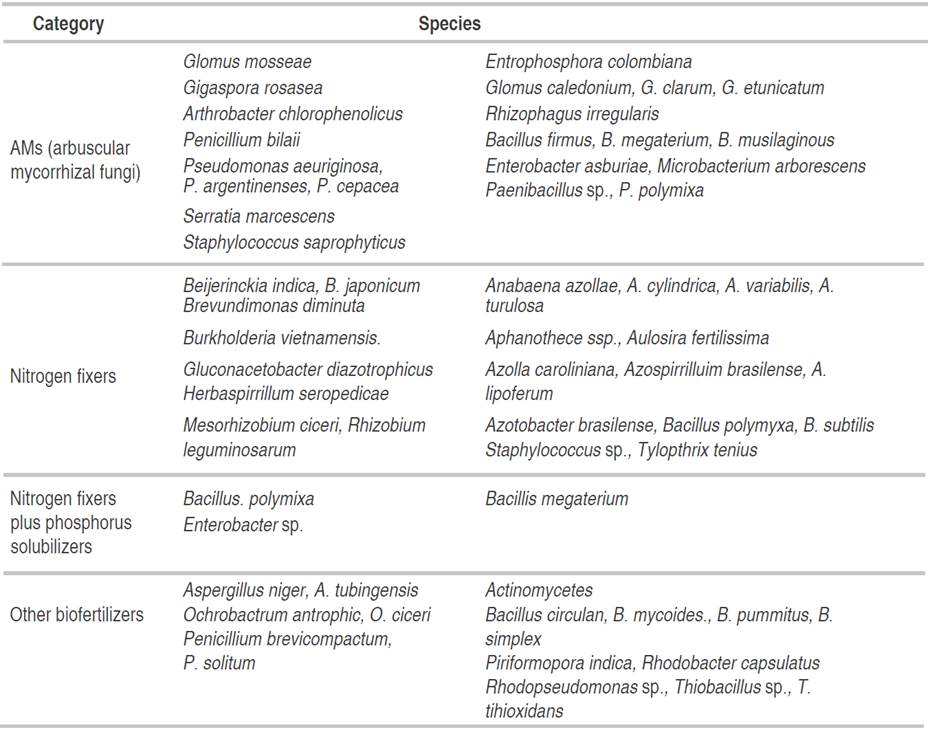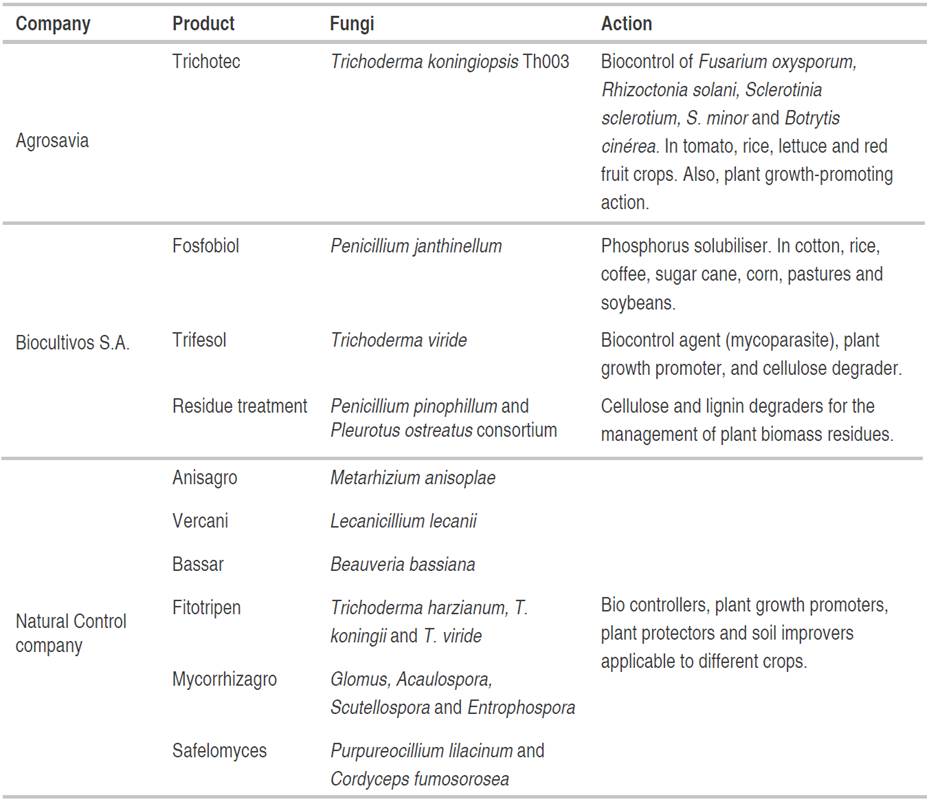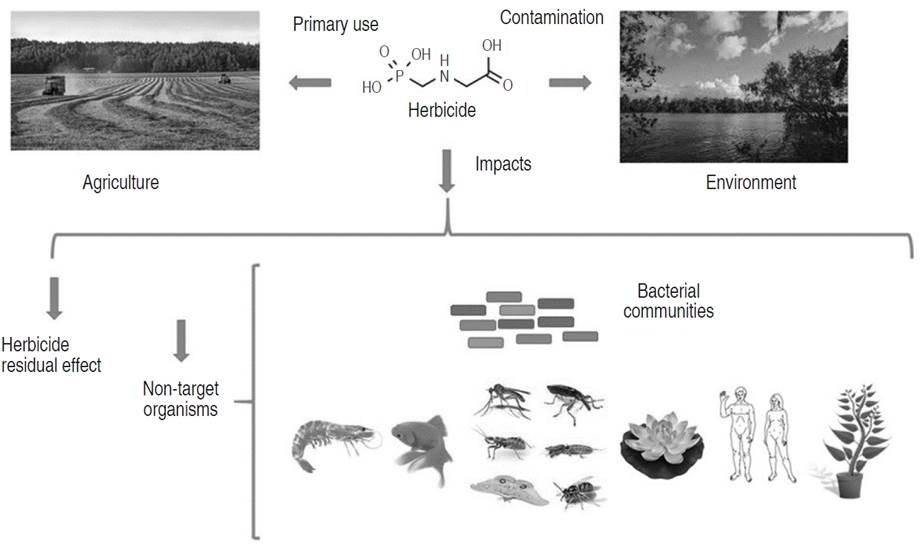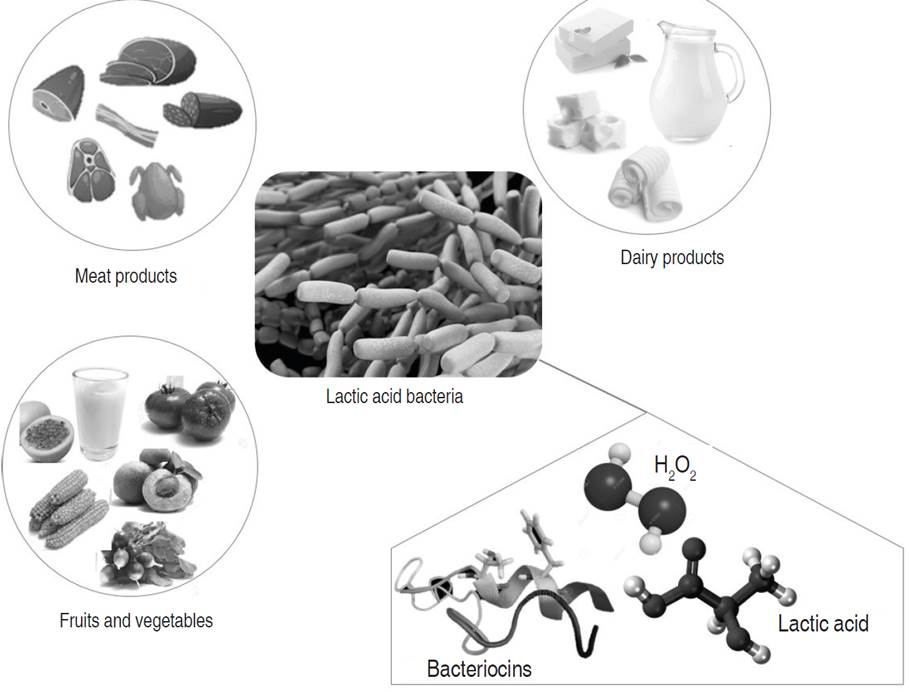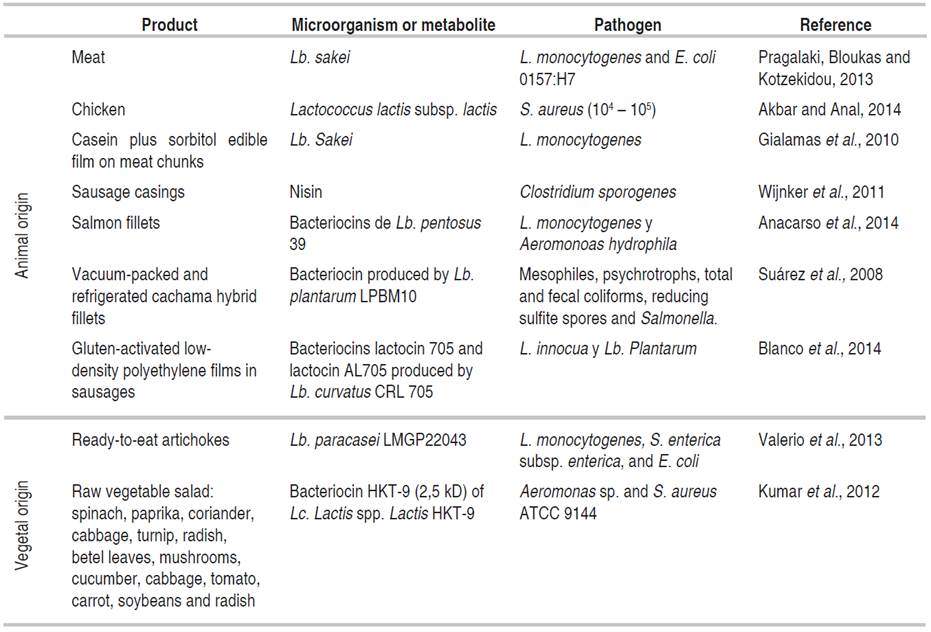In recent decades, awareness of has increased for the depletion of natural resources has increased in parallel with the exponential growth of the food industry. For the agricultural sector, achieving high yields in crops production is required to meet the increasing food demand, which influences negatively sustainable production goals (Tyagi et al., 2022). This has resulted in the excessive use of fertilizers and pesticides, which affects the production chain and causes serious environmental problems. Production chain of food depends on the relationship between microbial diversity and plants. For example, microorganisms maintain the soil health in different ways. They participate in the cycling of nutrients and process the waste (not only biological, but also chemical) using their enzymes. Some factors as high levels of toxic molecules (Shuaib et al., 2021) or changes in pH (Zhang et al., 2015) causes the loss of microbial diversity caused by chemical pest control and fertilization. This reduces the possibility to obtain the nutrients and minerals delivered by the microbial metabolism. Therefore, sustainable agriculture that protects the environment is needed, nowadays many researches around the world are studding new ways to produce food using ecofriendly process. They take advantage of existing microbial communities in different ecosystems, studying the microbial role in the biogeochemical cycles and develop natural products for the benefit of food production.
The investigation of the metabolism of microorganisms has shown their ability to contribute in soil and crop remediation processes. Bioprospecting as a tool to search new alternatives for fertilization or biological control of pathogens could minimize the use of chemical substances and in the long term could contribute with preserving the environment. In Colombia, microbial bioprospecting is very important in the environmental, industrial and veterinary medicine sectors, with research focused on the potential of microorganisms (Melgarejo, 2013). The environmental advantages of using microorganisms are evident in agricultural activities. The metabolic products decontaminate soils and degrade polluting residues by improving the structure of soils and promoting nitrogen fixation or solubilizing phosphates (Montenegro et al., 2020). For example, herbicides as Quinclorac have been used in the word, also in Colombia for controlling undesirable grasses in the rice fields (Shi et al., 2017). Residues of Quinclorac in the soil can cause serious phytotoxicity in sensitive plants and for the recovery of the soil health it can be used techniques such as bioremediation. It has been reported that strains of different genera as Bacillus megaterium Q3, Burkholderia cepacia, Bordetella sp. strain HN36, Alcaligenes sp. Pantoea sp. QC06 can metabolize this herbicide. Biomass cultured in liquid medium of the isolates strains was applied directly over samples quinclorac-contaminated soil and de biodegradation was performed. Some possible ways to do this transformation are through the reduction of carboxyl, or through dechlorination of quinclorac (Liu et al., 2014). For development of those products, the biomass is produced in bioreactors obtaining homogeneous cell suspensions produced under optimum conditions that must keep the viability after application on field (Tyagi et al., 2011).
Additionally, these microorganisms can protect crops from pests and pathogens since several microbial metabolite's present antimicrobial activities, serving as potential biological controllers. Therefore, bioremediation, biological control, biostimulation, and bionutrition promote more productive, nutritious and healthy crops with fewer negative effects on the environment (Carranza, 2017). Bioprospecting offers possible alternatives through the use of biofertilizers based on microorganisms (microalgae, bacteria or fungi) applied to soil and plants to partially or totally replace synthetic fertilization. These microorganisms perform functions such as decomposition of organic matter, detoxification of pesticides, stimulation of plant growth and development, supplying nutrients to plants and soil, secondary metabolites and production of bioactive compounds such as vitamins and hormones that protect against pathogens (Vimal et al., 2017).
Application of products obtained from isolated strains with biofertilization or bioremediation traits reduce agrochemicals that become environmental pollutants in soil and water as a result of agricultural work (Armenta et al., 2010). Additionally, it can reduce costs for producers by using natural products obtained locally, increasing crop yields and offering the final consumer healthier products free of agrochemical residues, resulting in sustainable agriculture. Likewise, natural products reduce the application of toxic additives by providing alternatives for food biopreservation. The objective of this review was present some important laws that govern the use and exploitation of genetic resources in Colombia. Also, we elucidate the current state of bioprospecting in Colombia and the principal applications of microorganisms in the food production chain, focusing on agricultural uses of biofertilization and bioremediation and on biopreservation of food.
MATERIALS AND METHODS
Different scientific articles were reviewed in the databases of universities such as Universidad Nacional Abierta y a Distancia and Universidad Nacional de Colombia, along with articles in Scopus and search engines such as Google Scholar. Documents available from the Ministry of the Environment and other regulatory bodies were also reviewed. Decrees and laws of different years were reviewed independently of the date. The articles and thesis reviewed belong to a span of 20 years. According with the literature we divide the information in sections that deal with topics like regulations, applications and perspectives of the bioprospecting in Colombia.
RESULTS AND DISCUSSION
Bioprospecting or biological prospecting is a systematic process of searching for genes, natural compounds, or organisms in nature that have the potential to develop a product that benefits man (Oyemitan, 2017). Specifically, microbial bioprospecting is defined as the search for microorganisms with desirable characteristics that can be used in various industries to impart commercial value through the development of process and products in sectors such as cosmetics, biotechnology, pharmaceuticals, medicine, food, and agriculture, among others (Duarte and Velho, 2009; Beattie et al., 2010). This activity is based on access, characterization, and transformation for biological and genetic resources, obtaining products that can contribute to the solution of environmental, social, and various types of problems without affecting biodiversity.
Regulations
Because of the effect that resource exploitation has on humanity, bioprospecting has been addressed in international treaties and legal agreements to control biopiracy, which is the use of resources without the approval of original peoples or obtaining profits without respecting international treaties (Beattie et al., 2010). Access to genetic resources represents a development and conservation issue for the diversity of microorganisms and natural sources.
Once microorganisms have been obtained from different sources, they must be identified to have a detailed record of the different types of microorganisms in each sampled area. Then, a collection of microorganisms must be developed and studied, introducing the most viable alternative to sustainable industrial and agro-industrial processes. The storage site guarantees the conservation of microorganisms for important biological resources and genetic information. When determining areas with microbial diversity, conservation or exploration strategies can be developed, generating greater economic importance for the areas (DNP, 2011).
Colombia has different genebanks; the main one is located in the Corporación Colombiana de Investigación Agropecuaria (Agrosavia). Other entities such as the Instituto Colombiano Agropecuario (ICA), Pontificia Universidad Javeriana, Instituto de biotecnología at the Universidad Nacional de Colombia, and Instituto Humboldt also have collections of great interest. In Colombia, these banks are divided into three subsystems: animals, plants and microorganisms. The Instituto Humboldt is linked to the Ministry of the Environment and is the regulatory body for the conservation of genetic diversity for different species. Genetic resources are the property of the Colombian state; they are inalienable, imprescriptible and unseizable (Rojas et al., 2016). Access in the form of genes and derived products is regulated by Andean Decision 391, called the Common Regime on Access to Genetic Resources, which includes Peru, Ecuador and Bolivia (Álvarez-Tafur, 2014).
Andean Decision 391 states that the Andean community must guarantee a fair and equitable sharing of benefits derived from the use of resources and associated traditional knowledge, laying the foundation for the recognition and valuation of genetic resources and their derived products, promoting the conservation of diversity, and developing scientific, technological and technical capacities (Álvarez-Tafur, 2014). Table 1 describes some important laws used in Colombia in order to regulate the prospection activities in the country.
To avoid biopiracy, Colombia protects its genetic potential through legislation. The Instituto Humboldt is responsible for promoting, coordinating and conducting research on the conservation and sustainable use of biodiversity. Shaping the national biodiversity inventory and facilitating the efficient and permanent management of biodiversity information that is useful for the processes of information analysis and the generation of information products. Also, the institute take the decision-making and defines of policies related to activities of access and exploitation of genetic resources in Colombia.
National and international focus
At the international level, bioprospecting focuses mainly on secondary metabolites because of the economic impact on the pharmaceutical industry. This process has greatly developed this industry and has set guidelines for the innovation and application of technologies using metabolites with characteristics applicable to new products. Additionally, the search for biological molecules with biological activity has revealed the potential for applications in food and uses in different industries and for crop protection through the application of biological inputs. These developments are of great economic and environmental importance for the preservation of life (Melgarejo, 2013). Applications in food production are fundamental because of the magnitude of environmental impacts that agricultural practices and food processing have. In Central and South America, countries such as Costa Rica, Mexico, Brazil, Ecuador, Peru and Argentina have explored genetic biodiversity to carry out studies for environmental profits and the commercialization and elaboration of products (Domínguez et al., 2019). Pioneer countries in the field of bioprospecting include India, the United States, Brazil and the United Kingdom, which have the largest number of publications on this subject. Among the more than 5,000 patents registered with the U.S. Patent and Trademark Office, 90 are associated with plant-based medicines, of which 80% were developed from seven plants from India. That country also has plant genetic resources for food and agriculture, including the development of genetically modified varieties used for the development of agrobusinesses (Bavikatte and Tvedt, 2015). During the literature search, bioprospecting continues to generate several annual publications and to increase. Figure 2 shows the results in Scopus using the word "bioprospecting" as search criteria. According to the results, there are currently 2426 publications worldwide on bioprospecting, published up to November of 2022. 64 publications were carried out in Colombia, where records have been kept since 2006. The main area of interest is agriculture, a fundamental part of the food production chain. Pioneering entities for these publications include the Universidad Nacional de Colombia, Universidad de la Sabana, Universidad de Caldas and Universidad de Antioquia.
Bioprospecting in Colombia
Microbial bioprospecting is an expanding topic, where the benefits for economic development and environmental sustainability can be explored. It will be an important component in studies on ecological diversity in this country, as well as for knowledge on the structure of microbial populations. There are potential applications for the food production chain. Sustainable agricultural production systems can be developed, ensuring conservation of the country's biological and microbial diversity. Colombia has great diversity in species of fauna, flora and microorganisms, which represent an opportunity for research on microbial bioprospecting.
Research groups specialized in bioprospecting have conducted studies focused on bioactive principles in plants, bacteria, hive products and marine organisms. Beauveria bassiana is a fungus that has been used to control the coffee borer and has demonstrated usefulness for the food industry in Colombia (Antia et al., 1990). This form of biological control is still used today and is promoted by the coffee research center (Cenicafé). Likewise, there are studies on the isolation of volatile substances from vegetables and essential oils, on the identification and characterization of fungi, and on biological control of agricultural pests and diseases (Duarte, 2011), as well as in biopreservation of food. Another biological way to control pathogens are the application of metabolites of some bacteria, for example the bacteriocins is an option for replace synthetic preservatives (Jutinico-Shubach et al., 2020). On the other hand, these studies have contributed to alternatives for the recovery of contaminated areas through bioremediation practices and for reducing the use of agrotoxins applied during the food production in Colombia. INVEMAR (José Benito Vives de Andréis Marine and Coastal Research Institute) has been a pioneering research center for bioprospecting aquatic environments. This institute has 6 megaprojects, including two that are currently focused on bioremediation of contaminated environments. On the other hand, the research group "Studies on the use of Natural Marine Products and Fruits of Colombia" at the Universidad Nacional has as an area of interest that includes marine invertebrates, corals, sponges, algae, microorganisms and some species of plants obtained from marine environments as sources of bioactive compounds. This group has almost 30 research projects for the search and application of bioactive compounds for the cosmetic and health industries. The Bioprospecting Research Group of the Universidad de la Sabana focuses on the search, isolation, characterization, evaluation and scaling at an industrial level of genes, proteins and metabolites in macro and microorganisms obtained in different environments of Colombia. This group has 11 research projects currently underway that are dedicated to the search for bioactive compounds and their modification with biological and industrial potential. The Universidad de Antioquia has two lines of research related to bioprospecting. One of them is called "Ecology of populations, communities and ecosystems" and has the research group "Microbial Ecology and Bioprospecting". In this line, projects have been developed in biological control, molecular biology of fungi, microorganism-habitat interaction, pollinator-plant and microbial decomposition of litter. The second line is "Biotechnology" whose work is based on the use of Colombian biodiversity (plants, animals and microorganisms) with basic and applied studies. Their work is developed in 3 research groups: Agrobiotechnology, Biotechnology and Biocontrol, and Environmental Microbiology. The center BioInc belongs to Universidad Icesi works to collaborate with the colombian industrial sector to promote the development of bioprocesses based on circular economy and proper use of biodiversity. They have two active projects, one of them "Meeting policy challenges for a responsible biodiversity based bio-economy in Colombia" and "Towards a sustainable bio-economy in Colombia: Organic residue valorization and bioprocessing". Also, they had finalized five projects which the mayor goal is to take advantage of the diversity to improve the agriculture in Colombia. The Centro de Investigación de Agricultura y Biotecnología (CIAB) at the Universidad Nacional Abierta y A Distancia (UNAD) has a line of research called Agricultural and environmental biotechnology with sublines for biofertilization, bioprospecting and bioremediation with 7 projects. The Bioprocess and Bioprospecting Research group at the Instituto de Biotecnología of the Universidad Nacional de Colombia has lines of research in Agricultural Microbiology and Bioprocesses with four biofertilizer products obtained through bioprospecting processes that have been patented and are currently commercialized. The Colombian company Ecopetrol created the Colombian Petroleum Institute 37 years ago in Piedecuesta (Santander) together with universities, research centers and national and international technology-based companies. Its focus is on the development of new processes and innovations, experimental tests and development of engineering and technological products. Its technological and scientific infrastructure consists of 9 laboratories comprising more than 40 experimental and analytical areas and 36 pilot plant units. The institution supports undergraduate and master's students nationwide with scholarships mediated by the Ministerio de Ciencia y Tecnología. Some of the research topics they develop are biotechnology, microbiology and molecular biology, bioprocesses and biofuels.
Agriculture
The so-called green revolution promoted the use of chemically synthesized fertilizer as a response to the demand for food worldwide that stemmed from uncontrolled population growth. This solution increased the use of fungicides and fertilizers that, by stimulating crop productivity, caused serious environmental problems such as soil salinization, loss of fertility and loss of organic matter (Medina, 2018). To care, protect and foment the development of sustainable agriculture, the application of beneficial microorganisms that improve production and control crop pests are part of the solution for the environmental pollutions. Several microorganisms have been identified and tested as beneficial elements for agriculture. At the Universidad Militar Nueva Granada, there are about 120 rhizobacterial isolates (Pseudomonas), five with biocontroller potential against Fusarium oxysporum. On the other hand, in Agrosavia, there is a collection of 303 filamentous fungi and 249 yeasts with biocontrolling potential for pest insects and soil, foliar and post-harvest phytopathogens, with a collection of 45 bacteria and five mycorrhizae with biofertilizing potential (Cotes et al., 2012).
According to a study carried out by MADS (Ministry of Environment and Sustainable Development), the IDEAM (Institute of Hydrology, Meteorology and Environmental Studies) and the U.D.C.A (University of Applied and Environmental Sciences) soils have lost quality and microbial diversity, generating lower agricultural production. According to the FAO (Food and Agriculture Organization of the United Nations), for 2015, 40% of Colombian soils had some type of erosion, with a reduction of land suitable for agricultural cultivation from 12% in 1961 to 8.1% in 2014 (Medina, 2018). Biofertilization takes advantage of beneficial microorganisms to improve soil conditions and colonizes the rhizosphere or the interior of plants where their metabolic processes benefit agricultural crops and pastures, which reduces or eliminates the need to use chemical fertilizers (Figure 3). Application of natural fertilizer decrease the adverse effects of remaining chemicals in food that affect the health of consumers. Also protects the environment meanwhile increase the food production, which are part of the global agenda for Sustainable Development Goals (SDGs). For example, one crop yield can increase by 10-40%, also the continuous application of biofertilizer of the land for years can retain fertility, keeping the added microbial community. Because they are environmentally friendly can be more economic using natural ingredients for the formulations (Seenivasagan and Babalola, 2021).
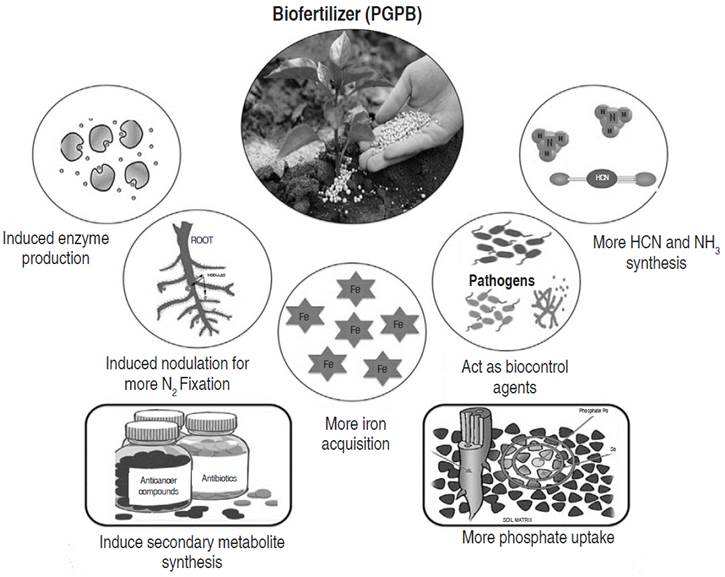
Figure 3 Benefits of biofertilization, use of plant growth promoting bacteria (PGPB). Source: modified from Singh et al., 2019
Several research has sought to develop products and processes that allow fertilization to be carried out naturally. The application of nitrogen fixators enhances crop production and growth of beneficial microorganisms for the soil (Carvajal and Benavidez, 2010). This has been demonstrated with N2-binding cyanobacteria strains such as Anabaena sp. UTEX 2576 and Nostoc muscorum (UTEX 2209S), and a polyculture of Chlorella vulgaris (UTEX 2714) and Scenedesmus dimorphus (UTEX 1237) in crops such as rice (Jochum et al., 2018), demonstrating that biofertilization benefits agriculture, the environment and health. Nitrogen is a limiting factor for rice crops growth, since producers must add inorganic N but it was not efficient. Authors demonstrate that biomass of the microalgae cultivated in a photobioreactor can improve the plant height under greenhouse conditions.
In addition to bacteria, fungi are also a fundamental part of the microbial biodiversity associated with plants. Mycorrhizae, a symbiotic association between a fungus and the roots of a plant, are also effective methods for biofertilization and bioprotection of crops (Carvajal and Benavidez, 2010). Arbuscular mycorrhizal fungi represent a promising microbiological resource for the development of sustainable agriculture (Guerra-Sierra, 2008). Biofertilizers that possess nitrogen fixation and phosphorus solubilization traits have been reported to have the greatest potential to improve crop yield, indicating the great potential of arbuscular mycorrhizal fungi (AMs) as one of the biofertilizer for most crops and climatic situations (Schütz et al., 2022). Table 2 shows the genera of microorganisms with potential use in biofertilization.
According with Ortiz-Moreno et al. (2022) in Colombia exist a diversity of product based on native fungi with agriculture applications. That products are the result of the biotechnological development and years of evaluating the biological activity of the native isolated fungi. Table 3 summarizes the examples mentioned by the authors.
Bioremediation as an alternative for the recovery of environments contaminated by agricultural practices and other industries
Environmental pollution due to the inadequate and excessive use of agrochemicals and fertilizers is a problem that is already being part of the agenda of world organizations. In 2012, the FAO established the Global Soil Partnership (GSP), which promotes sustainable soil management in agricultural tasks for food security and improved nutrition, adaptation, and mitigation of climate change and sustainable development (FAO, 2022). One of the alternatives for soil care is bioremediation. This is a low-cost technology that uses the metabolic traits of the microorganisms to decontaminate or recover an environment altered by polluting substances (Jochum et al., 2018). One of the advantages of this technology is applications in natural environmental conditions, guaranteeing decontamination and recovery of soils, with an economic, social and environmental sustainability benefit (Senthil et al., 2017).
Water, air and soil are affected by contamination with heavy metals such as mercury (Hg), arsenic (As), lead (Pb), cadmium (Cd), zinc (Zn), nickel (Ni) and chromium (Cr), products of activities such as agriculture and mining (Tchounwou et al., 2012). These metals can be found at different concentrations in fish, meat, milk and vegetables as a result of bio-accumulation, putting at risk not only human health but also food safety and the environment (Reyes et al., 2016). Cadmium is a heavy metal found naturally in the soil, but it is also introduced to the environment anthropogenically through phosphate fertilizers, increasing the normal load of the ore. This causes toxic effects on the health of humans, plants and animals. Once cadmium is absorbed by the body, it is housed in vital organs such as the kidneys and liver, remaining in the body for several years (Kumar et al., 2012). Cadmium and lead are heavy metals with the greatest tendency to accumulate in plants, causing severe imbalances in the processes of nutrition and water transport.
Several studies have demonstrated the ability of lactic acid bacteria (LABs) for water and soil treatments. Pediococcus sp., Leuconostoc sp. and Lactobacillus sp. have demonstrated their ability to reduce contaminants such as chromium, cadmium and lead (Petrova et al., 2022). It has also been shown that lactobacilli species such as Lactobacillus amylovorus, Lb. reuteri and Lb. dextrinicus are efficient at decontamination of sludge with CD and PB, providing a possible solution for decontamination of heavy metals in food and water (Kirillova et al., 2017). A study using Lb. plantarum MF042018 isolated on the shores of the Mediterranean Sea demonstrated great potential for the treatment of heavy metals derived from the manufacture of batteries, presenting biosorbent characteristics for the removal of heavy metals in industrial wastewater (Ameen et al., 2020). This type of work is fundamental for knowledge on the behavior of bacteria with potential in bioremediation. Likewise, it has been shown that there is greater effectiveness with a consortium of bacteria than with pure cultures, showing the metabolic pathways followed by different species of bacteria, which can have synergistic effects for the degradation of toxic compounds in certain environments (Zhang and Zhang, 2022). A study carried out with strains of Viridibacillus arenosi B-21, Sporosarcina soli B-22, Enterobacter cloacae KJ-46 and E. cloacae KJ-47, where parameters such as optical density, pH, urease activity, calcite production, tolerance to heavy metals and impermeability were monitored, showed that bacterial mixtures had greater resistance and efficiency for the remediation of heavy metals than the use of a single strain (Khan et al., 2016). The presence of heavy metals in soils, food and water sources is a global concern because decontamination processes can generate large costs; bioremediation is an economic and sustainable alternative applied in several countries (Yadav et al., 2017).
The control of plant species that compete with crops is carried out with herbicides that contaminate agricultural soils, river systems, and aquifers and change the structure and function of soil microbial populations. Herbicides directly or indirectly impact organisms other than weeds, even humans (Pileggi et al., 2020). Glyphosate is the most used chemical worldwide in agriculture; it is an herbicide that acts on all plant species by inhibiting the activity of enzymes that synthesize aromatic amino acids (Choque and Nogales, 2019). Those amino acids are essential for protein synthesis and are precursors for some secondary metabolites required for plant growth (Tzin and Galili, 2010). Several studies have reported residues of this herbicide in soils, water and food for human consumption, which can cause effects on health and the environment (Ruuskanen et al., 2020). A bioremediation study in glyphosate (GP) contaminated soils, comparing native strains and two introduced strains recognized as degrading: GP Achromobacter sp. Kg 16 (VKM B2534D) and Ochrobactrum anthropi GPK 3 (VKM B-2554D), demonstrated the efficiency of the strains introduced in the first phase in the laboratory. In the field, the introduced strains had greater efficiency in the biodegradation of GP (between 49.5% and 65.8%) than native strains that did not exceed 11% for GP biodegradation (Ermakova et al., 2010). This shows the great potential of bioprospecting activities to obtain strains with higher degradation activities that can be introduced into environments in a controlled manner. On the other hand, bacteria such as Bacillus pumilus, Streptomyces sp., Serratia marcescens, Alcaligenes sp., Penicillium sp. and Pseudomonas putida have been reported as organophosphate degraders. Among these species, B. pumilus has demonstrated the ability to degrade 300 mg L-1 of TCP chlorpyrifos (3,5,6-trichloro-2-pyridine) in 8 days. Additionally, it has been reported that molds such as Aspergillus terreus have degraded the same amount in 24 hours, which shows that this fungus has a greater ability to degrade organophosphates (Hernández-Ruiz et al., 2017). Figure 4 shows an outline of the impact of these chemicals.
On the other hand, economic losses caused by insect pests and nematodes in crops has forced the use of pesticides. Organochlorine compounds are fat-soluble, water-insoluble and highly toxic to plants and animals. These pesticides are absorbed by the soil and are difficult to degrade (Gregory et al., 2015), which is why they have been banned or restricted in several countries according to the Latin American Observatory of Environmental Conflicts. Organochlorines (alpha and beta endosulfans) can be found accumulated in different layers of soil. In one study, total degradation of these compounds was achieved using a bacterial consortium with the genera Bordetella petrii I GV 34, B. petrii II GV 36 and Achromobacter xyloxidans GV 47 (Odukkathil and Vasudevan, 2016).
The ability to assimilate agrochemicals of some species of fungi has been also demonstrated. One study demonstrated the degradation of heptachlor and heptachlor epoxide through the use of the macroscopic fungi Phlebia tremellose, P. brevispora and P. acanthocystis, achieving between 71 and 90% heptachlor removal and between 16 and 25% heptachlor epoxide (Dar et al., 2019). Species such as Penicillium miczynskii, P. Raistrickii, Aspergillus sydowii, Trichoderma sp., and Bionectria sp., obtained from marine sponges, have also demonstrated a capacity for biodegradation of organochlorine compounds (Parte et al., 2017).
Organophosphates are also highly toxic compounds that control pests such as insects, mites and nematodes (Badaii and Varela, 2008). These compounds can be found in everyday consumer products such as dairy, leading to public health problems. In one study was evaluated the degradation capacity of organophosphates by LAB during milk fermentation using different combinations of species of the genus Lactobacillus (Lb. plantarum 1.0317, Lb. plantarum 1.0624, Lb. plantarum 1.0315, Lb. brevis 1.0209, Lb. helveticus 1.0203, Lb. helveticus 1.9204, Lb. lactis 4.0611, Lb. bulgaricus L6 and Streptococcus thermophilus 3.0503), some with strong degrading activity and others weak. They observed that when combining strains that individually presented weak activity, there is synergism, and organophosphate pesticides are degraded more rapidly (Zhang et al., 2014).
Bioremediation in Colombia
In recent decades, water quality studies in Colombia have shown higher concentrations of heavy metals from increases in populations, industrialization and mining activities. There are reports of large concentrations of cadmium and lead in the Negro, Bogotá, Cararé, Marmato, Cauca la Pintada, Achi and Pinillos rivers (Reyes et al., 2016). On the other hand, Colombian soils have a large amount of heavy metals from agricultural work that takes place throughout Colombia, which becomes an important problem, since these compounds represent a risk for health and the environment. In the municipality of Codazzi (Cesar), large quantities of chemical inputs have been used in cotton crops for several years. In a study conducted by Kopytko et al. (2017) in this region, a recovery process for soils was carried out using varieties of native strains of the genera Pseudomonas, Aeromonas, Burkholderia, Bacillus and Enterobacter, which are reported in the literature as microorganisms with a high potential to degrade organochlorine compounds. Authors applied the bioaugmentation method to remove 56.2% of DDT (dichloro-diphenyl-trichloroethane), 17.1% DDD (dichlorodiphenyldichloroethane) and 44.5% DDE (chlorophenylethylene) for 8 weeks (anaerobic treatment) and 46.5% removal of DDT, 17.8% DDD and 8.5% DDE after 20 weeks (aerobic treatment).
In Colombia, the development of bioremediation processes began more than 25 years ago. Studies carried out by research groups from universities such as the Center for Microbiological Research (CIMIC) of the Universidad de los Andes, Universidad Nacional de Colombia in Medellín, and Universidad de Antioquia have compiled published studies on bioremediation in Colombia. In a study carried out in the municipality of Manaure (Guajira), a mixed culture strategy was developed to isolate halophilic bacteria with antibacterial and cytotoxic activity. The strain Vibrio diabolicus A1S was isolated and its production of bioactive metabolites was evaluated with biodegradable polyhydroxybutyrate (PHB) polymer. This material has plastic-like characteristics and has potential applications in different industries. The V. diabolicus A1S genome was sequenced to establish the genes responsible for the production of PHB and the metabolic pathways of this microorganism, where bioprospecting isolated at least 600 different microorganisms with potential industrial applications (Conde, 2019).
In one study, some actinobacteria were isolated from water and sediments of the Guaviare River with antimicrobial capacity over bacterial as Chromobacterium violaceum, Bacillus subtilis, Acetobacter baumannii and Klebsiella pneumonia and fungi as Colletotrichum gloeosporioides. These isolated strains represent a potential for future research with valuable contributions to medicine and agribusiness (Pastrana et al., 2016). In another study carried out in two riparian areas of the Arauca River, it was found that the combination of physicochemical pretreatments and the use of techniques such as MALDI-TOF MS facilitated the detection of low abundance actinobacteria with potential use as a source of antimicrobial agents (Arango et al., 2018). Another study reports the analysis of samples of deep marine sediments from the Caribbean Sea from which were isolated representatives of microbial communities that contribute to global carbon recycling. Also, in this study microorganisms with antimicrobial activity were isolated, evaluating their resistance to methionine, and 78 of these bacteria belonged to the Streptomycetaceae family. Three phylogenetic groups were found: Proteobacteria, Actinobacteria and Firmicutes. This information gives an estimation of the phylogenetic diversity and provides a first step to the creation of taxonomic inventories from existing microbial populations with bioremediation capacity (Blandón et al. 2022).
Applications of microbial bioprospecting in food processing
The processing of food after harvest called transformation, require preservation techniques because organic matter is susceptible to deterioration by microorganisms. Therefore, extending the shelf-life of food has been a challenge, which is why a large number of preservatives have been developed (Amit et al., 2017). These preservatives in many cases can be toxic due to their continuous consumption, causing in some cases long-term diseases. Which is why the consumption of less processed foods with fewer preservatives or from natural sources is a current tread (Gutiérrez-Cortés and Suarez, 2014).
Biotechnology is focused on food with alternatives for conservation. Bioactive molecules obtained from plants (essential oils, secondary metabolites, extracts), hive products or bacteria are capable of inhibiting or slowing down the growth of microorganisms that cause deterioration (Ferreira et al., 2021). One of the main groups of bacteria that are sought after for applications in food biopreservation are LABs because they are considered as GRAS (Generally recognized as safe), which allows them to be applied directly to food or in separate products. Figure 5 shows some sources of LAB used in bioprospecting processes.
Because of the ubiquity of LABs, it is useful to characterize the microbiota of fermented food producing regions through bioprospecting protocols for a natural source of genes to develop new initiating strains with antagonistic traits of great interest in food (Topisirovic et al., 2006). In general, the use of LAB as biopreservatives is an alternative of direct preservation since they eliminate competing microbiota, improving the characteristics of the product and extending the shelf-life without carrying out processes of separation of antimicrobial compounds. However, acidification of the fermented products orthe flavors produced because the microbial metabolites, sometimes are not desirables, so another alternative is purification, which can be added directly, such as lactic acid and bacteriocins (Gutiérrez-Cortés et al., 2018).
The use of LAB directly in food can give probiotic characteristics to the product (Giraffa, 2012), which must be done in the logarithmic or stationary phase at a concentration between 108 and 109 CFUs when consumed. They must be able to survive the storage conditions of the product, as well as the pH, water activity, carbon, nitrogen, minerals and oxygen (Rivera-Espinoza and Gallardo-Navarro, 2010). LABs are widely known for their presence in dairy products; however, there are other food matrices that can be fermented or be vehicles of probiotic biomass. In the case of fermented meats, LABs must withstand high salt concentrations (15% - aw: 0.85 - 0.86) and temperatures during production (4 to 7 oC during preparation, 18 to 24 oC during fermentation, and 12 to 15 oC during maturation) and low pH values (4.6 to 5.1) (Ammor and Mayo, 2007).
The LAB species most commonly used as initiators in meat fermentation are Lb. sakei, Lb. curvatus, Lb. plantarum, Lb. pentosus, Lb. casei, Pediococcus pentosaceus and P. acidilactici, which cause pH reductions below 5.1, preventing the growth of sensitive microorganisms, extending shelf-life, and modifying some sensory properties. LABs reduce pH by coagulating proteins, giving texture to the product and eliminating accompanying microbiota. Later, moisture is reduced by 70-80%, decreasing the aw, which also reduces the microbial load (Ravyts et al., 2012). Table 4 shows some examples of LAB applications in the processing of meat and plant-based products. A common denominator of these studies is the release of lactic acid and bacteriocins for the control of food pathogen populations.
Likewise, these matrices are used as a vehicle for probiotic microorganisms as an alternative to dairy products. Sheehan et al. (2007) evaluated the viability of Lb. salivarius, Lb. paracasei, Lb. rhamnosus, Lb. casei, and Bifidobacterium animalis in heat-treated orange juice (pH 3.65) (90 and 76 oC) and pineapple juice (pH 3.4). Pineapple juice inhibited the growth of Lb. rhamnosus and Lb. casei (2 and 1 log CFU mL-1 respectively) more than orange juice because of its lower pH; however, Lb. paracasei ssp. paracasei was not affected. Lb. salivarius was the most sensitive to acidity, demonstrating the possibility of introducing some strains of LAB in acidic fruit juices to preserve viability, improve the probiotic quality, and extend shelf-life (Sheehan et al., 2007). There are several studies that have shown the potential of fruit juices to convey probiotic bacteria while maintaining viability. Most studies were carried out with commercial strains; however, these matrices could be used in post-bioprospecting processes for the development of new products that contain this type of bacteria without using milk. Acevedo-Martínez et al. (2018) demonstrated the viability of Lb. casei in mango nectar using FOS 5% as a prebiotic substance and the acceptance of the product by a panel of consumers. Bernal-Castro et al. (2019) evaluated the viability of a commercial strain of Lb. casei in a drink prepared with red fruits and 1% inulin.
Hive products such as propolis have also been used as bioconservative substances in different food matrices. Studies demonstrated how propolis can replace synthetic preservatives to increase the shelf-life of fish sausages and fillets (Gutiérrez-Cortés and Suarez 2014; Suarez et al., 2008). Propolis can also be used in microencapsulates for edible films that prolong the shelf-life of fish fillets, as demonstrated in a study by Piedrahita et al. (2018). In addition, a mixture of microencapsulated propolis and chitosan were also used to prolong the shelf-life of packaged pork, using electrospun polycaprolactone in linear low-density polyethylene (Vargas et al., 2021).
CONCLUSION
Faced with the global targets for sustainable development, it is very important to take into account the role of bioprospecting throughout the food production chain. Food production increasingly requires new technologies and increases in capacity. That increment has to be developed in a responsible way, then the reduction of agrochemicals and additives is a goal. Taking into account that agriculture activities are responsible of an important part of pollution of soils and water as a result of the pest control or fertilizations, it is necessary the use of natural substances that recover soil and bodies of water and controlling organisms that affect crops and that cause post-harvest deterioration. There are more and more applications of native microorganisms and bioactive compounds in the production and transformation of food, which is why, in Colombia, this initiative is increasing. While there have been advances in bioprospecting in Colombia, these efforts also need to be directed towards the agricultural industry.














